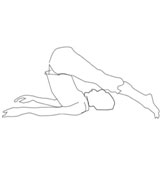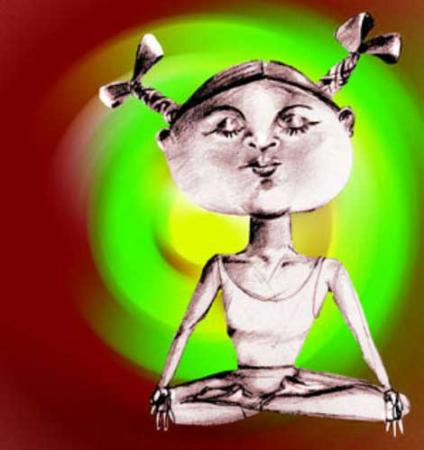 The word Yoga is derived from the Sansrit word Yuj , means Yoke, which is used to tie or bind the oxen by the farmer to till the land.Here in this context Yoga ties or yokes our body and soul together.
The word Yoga is derived from the Sansrit word Yuj , means Yoke, which is used to tie or bind the oxen by the farmer to till the land.Here in this context Yoga ties or yokes our body and soul together.
Why Body and soul should be yoked
The ancient Seers, the archetects and the builders of Yoga thought that the body and soul must function in harmony. In unison.According to Yoga Sutra of Sage Patanjali, , in order to have a system where in body and soul work together in harmony, 8 stages of yoga are prescribed which are well known with the name Ashtangayoga.
Ashtangayoga
Ashta in Sanskrit means Eight and Anga means Limb. The eight limbs of Yoga prescribed in the book "Yoga Sutra" by sage Patanjali stipulated certain conditions for are
- Yama
- Niyama
- Asana
- Pranayama
- Pratyahara
- Dharana
- Dhyana
- Samadhi
Now, let's see each of the eight limbs of Yoga in detail.
Yama
Yama means, control. Remember the reins used to control a horse? In the context of yoga, for achieving good results from Yoga, Sage Patanjali has prescribed five ways or practices in his Yoga sutra. The following five practices are required to be adhered to to enjoy the fruits of Yoga.They are
Non- Violence or Ahimsa
Ahimsa or Non- violence is the art of Practising kindness, love and compassion and camaraderie .It also stresses on patience, self- love, trust and understanding.
Truthfulness or Satya
In his treatise 'Yoga Sutras', Sage Patanjali describes Truthfulness or Satya as, "A state of Harmony with Mind (Manasa), word (Vaacha),and Action(Karma).This means a person who adheres to truthfulness will utter what he or she think in mind. In a nutshell truthfulness is nothing but being true to the heart.
Not indulging in stealing or Asteya
Next comes the third constituent of Ashtanga Yoga.Not acquiring or non-grabbing other's possessions by force or by deceit is known as Asteya.jealously eager for the possession of something which is not yours is termed as a sacrilege.
Celibacy or Brahmacharya
Any sensual pleasure, be it mental physical. or vocal is unwanted and undesirable according to the next aspect of Yama. This characteristic in a person is recognized as "Divine." But the thing to be noted here is Celibacy should not be taken as a life-long criteria. The yama means, "Moderation in sex"."Celibacy" has been recognized as the most coveted of all the virtues by the ancient texts Vedas, Puranas and Smritis.
Abandoning or banishing mundane pleasures
In Sanskrit the word "Aparigraha" means relinquishing worldly pleasures. Getting detached from the worldly pleasures is the prime requisite for any individual to attain this state of "Aparigraha."
We have seen first of the Asthanga yoga, "Yama" and its five sub sects., let's proceed to the second of the Ashtanga yoga, Niyama in detail.
Niyama
Niyamas are all about, how we interact with ourselves. They are about rules to be adhered to to discipline ourselves. They may be physical or mental disciplines. There are different versions about the number of constituents. Sage Yajnavalkya stipulated ten Niyamas, while Bhagavad Gita stipulated 11 Niyamas.
But Sage Patanjali prescribed only 5 Niyamas. They are as follows :
Shaucha or Cleanliness
Shaucha implies both physical and mental purity.The great Sage Manu says, water purifies the body.Truthfulness purifies the mind. Soul is purified by knowledge and austerity. In a nutshell Shaucha underlines the importance of maintaining purity in intellect, and purity in body.
Santosha or contentment derived out of happiness
"Be Happy and be content with the things you have. If you are content with one fridge, you need not go for fridges in each room. Here moderation in your wants is stressed.The more you manage your life with less needs, the more your will be blissful. A person who acquires this stage will not be affected by any scarcity. And obviously, he will not be perturbed by external conditions or lack of conditions.
Tapas or austerity
The state of Austerity is achieved by practising a simple living and maintaining purity in thought, speech and action. It all amounts to a person who lives by example. By doing what he or she preach.
Svadhyaya or Self- study
The meaning of Svadhyaya is self study. Studying and fortifying the self with richness of the knowledge derived from Vedas and Puranas. By learning and interacting with seers
Ishwara Pranidhana or surrender to god.
The process of surrendering to god through devotion and dedication of all your actions performed through intellect, speech and body.
After seeing the characteristics of Yama and Niyama, we will see now the benefits of them
Benefits
By leading a life in accordance with the Yamas and Niyams stipulated by the venerable sages one can lead a conscious life. Yamasd and Niyamas teach us to be true to our self. Mainly they impress upon us the necessity of yoking or tying Body and Soul together.
 Asanas, the next in the Astanga Yoga list.
Asanas, the next in the Astanga Yoga list.
As mentioned above, entire Yoga revolves around binding Body and Soul together. Asanas or Postures take us towards the main crux of Yoga. There are many Asanas and all of them are designed to impart flexibility to the body in order to facilitate the flow of vital energy incessantly.Unlike physical exercises Yoga gives exercise to the internal organs. This leads to a complete assurance of health benefits physically and mentally. And this is what Yoga is designed for by the great seers.
Another greatest advantage of Yogasanas is that it doesn't need any elaborate and expensive equipment like physical exercises and Gyms. What all it needs is a small place, where there is place for sitting and stretching.
Yogasanas work effectively in keeping the Body's eliminating system in tip top condition. Thus making the body immune to any kind of ailment.
The body becomes flexible and makes a yoga practitioner look very young.
Yogasanas are to be performed in a particular way stipulated by the seers.
In order to extract the full benefits of Yoga, the following precautions are to be taken
For practising Yogasanas, the most ideal time would be morning hours preferably before Sun rise. Make it a point not to start Yogasanas only after emptying the bowels and the bladder.
Choose an even place for doing Yogasanas. See that the place is far from noises. Don't sit on the bear floor. Sit on a mat or a soft piece of cloth. These cloths are available in YOGA stores.. The person who does the yogasanas should wear clothes according to the season. The thumb rule for both men and women are the clothing should not cause inconvenience to the performer.
It must be ensured that there should not be any deviations like blaring music, Telephone or cell alarms. Utmost importance has to be given to concentrating on breathing trend and the resultant reaction in the limbs.
After performing an Asana, its advised to do Shavasana, because it restores the normal breathing and calmness to body and soul.
Entire performance process of any Asanas should be in a smooth way. There shold not be brisk or jerky movements.
Don't tax the body with a heavy workout. Care should be taken to gradually increase the 'change.' And gradually increase the duration as the time passes on. In a nut shell, any increase in speed or duration of an Asana should be in small increments.
If you are a rank beginner of Yogasanas, you must take the help and guidance of a guru in yoga.
Light food is advised to keep the body light. Women four months after conception and three months after delivery .
A woman should not do Yogasanas during menstruation.
Don't be eager to perform all the yogasanas on the same day. The Yoganas should be performed in a gradual step by step manner.
Shavasana should be your final Asana of the session. Shavasana brings back the orignal state of the body after a session of Yogasanas,
Different kinds of Yogasanas
Following are the different kinds of Yogasanas
- Sitting postures
- Supine postures
- Abdominal Postures
- Hsand Postures
- Kneeling Postures
- Leg postures
- Head Postures
Now comes Pranayama, Fourth limb of Astanga yoga.
Pranayama means 'Breath control'. Pranayama is all about controlling and regulating the vital energy of the body in the best possible way so that the vital energy is directed to fortify the body to save it from all types of ailments mentally and physically.
Pratyahara, the fifth limb of Ashtanga Yoga
Pratyhara means controlling the senses. We know our senses always orient towards worldly pleasures. Yoga tells this orientation of the sense should be controlled in order to direct inwards to acquire a higher degree of excellence.
Dharana, the sixth limb of Ashtanga yoga
Dharana means concentration. Focusing is necessary to see the things in real perspective.Focusing is absolutely necessary to keep the wavering thoughts at rest.
Dhyana, the seventh component of Ashtanga yoga.
Dhyana is meditation. When the mind holds its attention sans distraction, the power of the mind becomes enormous. Owing to this reason our wise men of yore resorted to meditation and acquired unlimited knowledge.
Samadhi, last of Ashtanga yoga
Samadhi means self realisation. Means. a person who attains this state will be able to see completely in to himself and utilize his inner strengths to acquire highest of the honours in all the fields. Samadhi for all practical purposes can be treated as the pinnacle of meditation. The highest form of meditation
Now Ashtanga yoga is spread well before you
Now the ball is in your court. Play it if you want to make your life a worthy life